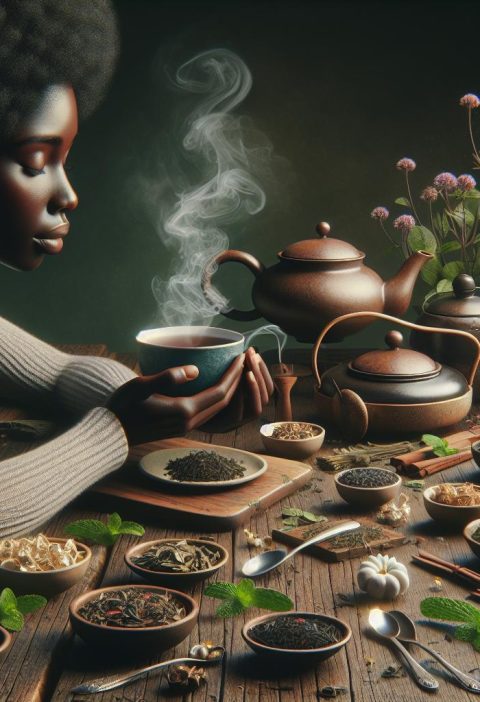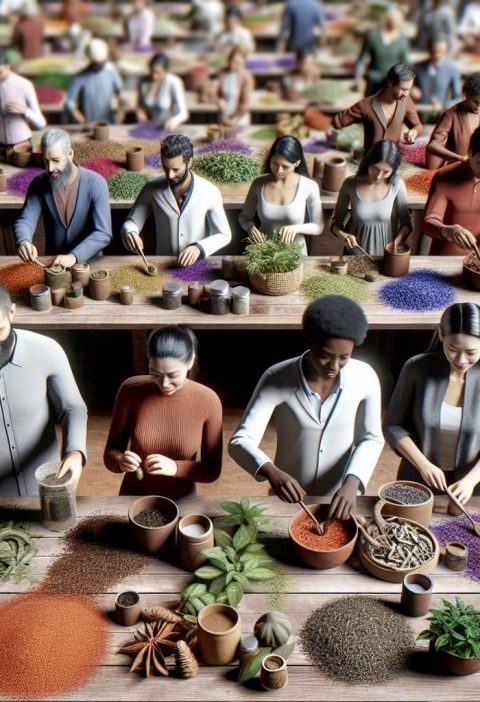So, we’re diving into the world of tea blending, where we get to unleash our creativity and craft unique flavors that cater to our taste buds. Whether you’re a seasoned tea enthusiast or just starting to explore the vast tea universe, blending your own tea can be a rewarding experience. By combining different teas, herbs, spices, and botanicals, we have the power to create personalized blends that suit our mood, health needs, or simply our flavor preferences.
With a myriad of ingredients at our disposal, the possibilities for tea blends are endless. From soothing chamomile and invigorating ginger to fragrant lavender and earthy rooibos, we can mix and match flavors to concoct the perfect cup of tea for any occasion. Join us as we embark on a journey to discover the art of enhancing tea with homemade blends, unlocking the secrets to creating teas that are not only delicious but also tailored to our individual desires.
Exploring Different Tea Bases
When it comes to creating your own tea blends, the tea base plays a crucial role in determining the overall flavor profile and characteristics of your concoction. Let’s delve into a variety of tea bases you can choose from to kickstart your blending journey.
For Novices: Getting Started with Tea Bases
- Black Tea: Known for its robust flavor, black tea serves as an excellent base for bold and rich blends.
- Green Tea: With its fresh and grassy notes, green tea provides a light and refreshing base for delicate blends.
- Herbal Tea: Herbal infusions, such as chamomile and peppermint, offer caffeine-free options with unique flavors.
For Intermediate Blenders: Elevating Your Creations
- White Tea: Delicate and subtly sweet, white tea adds a gentle base for blending nuanced flavors.
- Oolong Tea: Partially oxidized, oolong tea strikes a balance between black and green tea, offering complex notes for your blends.
- Earl Grey: Infused with bergamot oil, Earl Grey black tea brings a citrussy twist to your blends.
- Pu-erh Tea: Aged and fermented, pu-erh tea imparts earthy and deep flavors, ideal for complex and mature blends.
- Matcha: Powdered green tea, matcha offers a vibrant and concentrated base for unique and intense flavor profiles.
- Rooibos: Hailing from South Africa, rooibos is a caffeine-free base with a naturally sweet and nutty taste.
Experimenting with various tea bases allows us to craft distinctive blends tailored to our preferences and moods. Let’s continue our tea blending journey by exploring the vast world of complementary ingredients that can elevate our homemade tea creations.
Selecting Herbs, Spices, and Botanicals

When it comes to enhancing teas with homemade blends, selecting the right herbs, spices, and botanicals is crucial to creating unique and flavorful brews that cater to various tastes and preferences. For beginners dipping their toes into tea blending, starting with common, versatile ingredients is a great way to get accustomed to the process.
For Beginners: Mastering the Basics
- Begin with familiar flavors like mint, citrus, or ginger.
- Experiment with cinnamon, lavender, or chamomile for added depth.
- Consider using dried fruits such as lemon peel or orange zest for a subtle sweetness.
For Intermediate Blenders: Enhancing Your Blends
- Incorporate herbal favorites like lemongrass, hibiscus, or vanilla beans for complexity.
- Spice things up with ingredients like cardamom, star anise, or black pepper.
- Explore the world of botanicals with ingredients like rose petals, lavender buds, or jasmine flowers for a floral touch.
- Dive into unique and exotic ingredients such as elderflower, saffron, or lapsang souchong tea.
- Create signature blends by combining herbs like nettle, fennel, or coriander for a personalized touch.
- Elevate your blends with rare finds like matcha powder, turmeric, or angelica root for an unparalleled taste experience.
Experiment, mix, match, and allow your creativity to guide you in crafting distinctive tea blends that reflect your personality and flavor preferences. The world of tea blending is vast, offering endless opportunities to create beverages that delight the senses and bring joy to tea enthusiasts everywhere.
Techniques for Blending Tea
When it comes to blending tea, there are various techniques that can elevate your tea experience. Whether you’re a novice or an experienced tea enthusiast, mastering these methods can help you create delightful and flavorful blends. Below, we’ve outlined techniques suited for different levels of expertise:
For Beginners: Embracing the Basics
- Start by blending common ingredients like mint and citrus to create simple yet refreshing teas.
- Experiment with lighter flavors to get a feel for how different ingredients complement each other.
- Focus on balance and proportion to ensure your blends are harmonious.
For Intermediate Blenders: Exploring New Horizons
- Incorporate lemongrass and hibiscus into your blends for added complexity and depth of flavor.
- Consider blending green and black teas to play with different levels of caffeine and aroma.
- Learn to layer flavors by combining ingredients with contrasting profiles to create intriguing teas.
- Dive into exotic finds such as elderflower and lapsang souchong tea to push the boundaries of traditional tea blends.
- Experiment with infusions and cold brew methods to extract maximum flavor from your ingredients.
- Personalize your blends by adding your own unique twist, whether it’s a hint of spice or a touch of sweetness.
By honing these blending techniques, you can unlock a world of possibilities and create tea blends that cater to your unique palate and preferences. Let your creativity flow as you explore the art of blending tea.
Storage and Brewing Tips
When it comes to enhancing tea blends, proper storage and brewing techniques can make a significant difference in the final flavor. Here are some helpful tips catered to different experience levels:
For Beginners: Getting Started Right
- Store your tea blends in airtight containers away from direct sunlight and strong odors to maintain freshness.
- Use filtered or spring water for brewing to enhance the taste of your blends.
- Aim for consistency in brewing time and temperature to develop a sense of familiarity with your blends.
For Intermediate Blenders: Elevating Your Brew
- Experiment with different brewing methods such as steeping, cold brewing, or using a tea infuser to experience diverse flavors.
- Consider the water temperature based on the type of tea you’re blending to bring out the optimal taste profile.
- Incorporate flavor layering by adding complementary ingredients gradually to achieve a harmonious blend.
- Explore tea aging techniques to develop deeper and complex flavors in your blends over time.
- Engage in sensory evaluation to refine your palate and understand the nuances of each ingredient’s contribution.
- Personalize your blends by incorporating rare or exotic tea varieties to create distinct and sophisticated flavor profiles.
Remember, the journey of enhancing tea with homemade blends is as much about experimentation as it is about precision. By delving into the art of storage and brewing with these tips, you can unlock a world of exquisite tea experiences tailored to your preferences and creativity.
Creating Your Signature Tea Blend

For Beginners: Starting Your Blending Journey
- Begin by selecting quality base teas to form the foundation of your blend.
- Experiment with flavor accents like herbs, spices, or dried fruits in small quantities.
- Consider using pre-made blends as inspiration to understand flavor combinations.
For Intermediate Blenders: Elevating Your Creations
- Explore layering flavors by adding ingredients in stages during blending.
- Pay attention to water temperature and brewing time to bring out diverse tastes.
- Try out aging techniques to develop deeper and more complex flavors in your blend.
- Engage in sensory evaluation to refine your blend based on aroma, taste, and appearance.
- Source rare and high-quality teas to add uniqueness to your blend.
- Experiment with unconventional ingredients such as floral petals or rare spices for a creative twist.
- Personalize blends further by exploring exotic teas from different regions around the world.
- Refine your technique by conducting multiple taste tests to adjust flavor profiles meticulously.
| Level | Recommendation |
|---|---|
| Beginners | Start with quality base teas |
| Intermediate | Experiment with flavor layering |
| Experts | Source rare and high-quality teas |
Conclusion
Creating homemade tea blends is a rewarding journey that allows us to tailor our tea experience to our unique preferences. By following the tips shared in this article, we can elevate our tea-drinking rituals and explore a world of flavors right in our own kitchens. From experimenting with different base teas to incorporating unexpected ingredients, the possibilities for crafting personalized blends are endless. Whether we are beginners looking to dip our toes into the art of blending or seasoned enthusiasts seeking to refine our techniques, the key lies in embracing creativity and allowing our taste buds to guide us. Let’s embark on this flavorful adventure and savor the delightful nuances that homemade tea blends have to offer.






